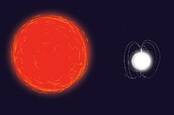This article is more than 1 year old
Astroboffins spot hefty pair swinging together. What? Um, we're talking about record-breaking massive binary stars...
What did you think we meant?
Astronomers have discovered the closest and most massive binary star pair, according to the latest research.
The star known as PDS 27 and its companion are two gigantic balls of plasma classified as massive young stellar objects (MYSOs). They have an estimated combined mass of about 12 times that of the Sun, and are locked at a distance of just about 4.5 billion kilometres (2.8 billion miles) from each other, roughly the distance between the Sun and Neptune.
“With PDS 27 and its companion we have now found the closest, most massive young stellar objects in binaries resolved to date,” said Evgenia Koumpia, a research fellow at the University of Leeds in England, and first author of a paper revealing the results, published this week in Astronomy & Astrophysics.
Spotting these types of stars is difficult since they aren’t around very long. Unlike our Sun, which gets to trundle along to a nice ripe old age, massive stars live life more dangerously. Their giant sizes mean they have to burn through copious amounts of their reserves much more quickly, and their lifetimes are only on the order of a few million years compared to the Sun’s ten billion.
“This is a very exciting discovery, observing and simulating massive binaries at the early stages of their formation is one of the main struggles of modern astronomy,” said Koumpia.
"There is a shortage of known young massive binary systems in charted space. High mass stars have comparatively short lifespans, burning out and exploding as supernovae in only a few million years, making them difficult to spot. This limits our ability to test the theories on how these stars form."
Well, luckily, the international team of researchers found another pair of these types of binaries. PDS 37 and its companion star are slightly smaller with a combined mass of 11 solar masses and separated by a further distance, about as far away as the Sun is from Pluto: 5.9 billion kilometres, or 3.7 billion miles.
Both these binary systems were found by analysing data taken from the European Southern Observatory’s Very Large Telescope Interferometer (VLTI). An instrument known as PIONIER, collects the light from four telescopes to make out the companion stars in each system. The researchers hope that their discovery will help scientists understand how such massive stars form.
“The next big question – which we have tended to avoid so far because of observational difficulties – is why so many of these massive stars are in binary systems?," said Rene Oudmaijer, a professor at Leeds uni, and a coauthor of the study.
“It has become increasingly clear to astronomers that massive stars are almost never born alone, with at least one sibling for company. But the reasons why that is the case are still rather murky.
“Massive stars exert significant influence on their cosmic environment. Their stellar winds, energy and the supernova explosions they generate in turn can impact the formation of other stars and galaxies. The evolution and fate of high-mass stars is quite complex but previous studies have shown that they can be influenced to a large degree by their binary properties.” ®

